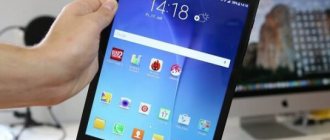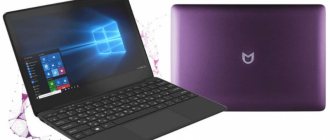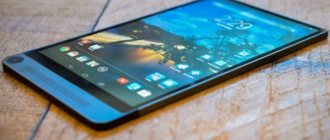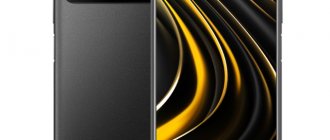Redmi 9A
The ultra-budget device, included in the Xiaomi phone rating, received both critical and enthusiastic reviews from customers. Therefore, it is recommended to think carefully before purchasing it from an electronics store.
| Options | |
| Screen | 6.53”, IPS (HD+) |
| Camera | 13MP |
| CPU | Helio G25 |
| Battery | 5000 mAh |
The advantages of the model include a large display and a capacious battery that can withstand 2 days of operation without recharging. However, without NFC and with very weak hardware, the Redmi 9A is difficult to compete with more attractive devices from Xiaomi.
Pros:
- ergonomics;
- screen diagonal;
- autonomy.
Minuses:
- no NFC;
- shell glitches.
Top 5 best Xiaomi smartphones under 15000
In order to get a complete picture of the models in this price range, let's take a closer look at them.
Redmi Note 3
It is suitable for those who need a high-performance device, without the slightest hint of lag, even under increased loads. Impressive performance is achieved thanks to the 6-core Qualcomm Snapdragon 650. Its advantage is an excellent display, the diagonal of which is five and a half inches and the resolution is 1920x1080.
If you like to take photographs, then the camera resolution of sixteen and five megapixels is enough to take excellent photos in any, even the most difficult conditions. The product also received positive reviews because it is equipped with an energy-intensive 4050 mA/h battery.
Mi Max
In second place is Mi Max, which is the undisputed leader in screen size: as much as 6.44 inches at 1920x1080! On the one hand, you can comfortably watch video files on it, but on the other hand, it is quite difficult to hold in one hand, especially for those with a small hand.
This is where the main disadvantages of the device end, and it’s time to talk about the advantages. Despite its solid power (a six-core Snapdragon 650 is installed), it can easily withstand up to 2 days of operation without recharging. This became a reality thanks to the 4850 mAh battery.
In addition to a fingerprint scanner and 4G support, the device boasts 16 and 5 megapixel cameras.
Redmi Note 4
A distinctive feature of another participant in our top is the Mediatek Helio X20 processor, running on 10 cores with a clock frequency of 2.1 GHz. It is capable of tasks of any level of complexity, however, as reviews indicate, under increased loads the device can heat up.
In terms of other functions, the product is in the middle segment: these are 13 and 5 megapixel cameras, a five and a half inch display. It is among the leaders due to its excellent 4100 mA/h battery and metal case.
Redmi Pro
Redmi Pro deservedly made it into our rating, with high-quality and powerful hardware - this is the Mediatek Helio X25. It is characterized by decent performance, which will be appreciated by fans of energy-resource games. The dual camera will delight you with budget-quality pictures (five and thirteen megapixels), and the 5.5-inch FullHD sensor transmits images in natural shades with good contrast.
The popularity is promoted by a capacious 4050 mAh battery, traditional functionality for the middle segment - a fingerprint scanner, 4G LTE.
MI 5C
This is a unique development of the company, which is enclosed in a metal case. The exclusivity lies in the fact that Xiaomi's first own development is installed - the 8-core Pinecone Surge S1 processor based on the 28 nm process technology.
The glossy screen of five and fifteen inches with FullHD and JDI matrix is pleasantly impressive. Despite the metal body, the phone weighs a little - 132 grams. There is a fingerprint sensor on the front panel. The capabilities of the photo module are small - 12 megapixels, but there is a double LED flash. The downside is the small battery (2860 mA/h).
We introduced you to the best Xiaomi smartphones in a given price segment. We have collected up-to-date information for you and hope that our review will help you make the right choice.
Redmi 9C 3/64GB (NFC)
The model, devoid of the shortcomings of the Redmi 9A, has under the hood all the essentials that a user may need in 2021.
| Options | |
| Screen | 6.53”, IPS (HD+) |
| Camera | 13MP + 2MP |
| CPU | Helio G35 |
| Battery | 5000 mAh |
Of course, the cameras installed here do not allow you to count on getting excellent pictures. However, you need to understand that the smartphone belongs to the ultra-budget segment, where the presence of NFC and a good chipset plays a decisive role.
On a note. The Redmi 9C is also sold without the NFC prefix, which lacks support for contactless payments, but also has an additional photosensor.
Pros:
- working hours;
- interface stability;
- contactless payment for purchases.
Minuses:
- grainy display.
Why choose a Xiaomi smartphone?
Firstly, the Xiaomi family of smartphones has a good price-quality ratio. Not everyone is in favor of spending a fortune on a good-quality phone, especially knowing that it was produced at a much lower price. Fortunately, phones from this brand, even flagship models, have quite affordable prices, which does not reduce their value as smartphones that offer a lot of features. Compared to other manufacturers, Xiaomi allows you to enjoy modern technology and extremely fast performance at a price that most users can afford.
On the other hand, it is worth noting the high quality of workmanship, which is reflected not only in the design, but also in the resistance to mechanical damage. Obviously, without proper protection in the form of a case, which the manufacturer includes free of charge in the kit, the phone will not avoid scratches or broken glass. However, this does not change the fact that Xiaomi cases and screens are quite durable anyway. In addition, they have an interesting design and rich colors on the screen.
You might like TOP 10 best mini cameras you can buy in 2021
Finally, the last very important issue is software. Users can choose between MIUI overlay and pure Android versions, so you're dealing with far-reaching customization options that don't result in inferior quality or slower phone speeds
Redmi 9 4/64GB (NFC)
A smartphone of an even higher level, both in terms of performance and photographic capabilities.
| Options | |
| Screen | 6.53”, IPS (FullHD+) |
| Camera | 13MP + 8MP + 2MP + 2MP |
| CPU | Helio G80 |
| Battery | 5020 mAh |
The quality of the images again cannot be called high, but the owner of the phone gets at his disposal a wide-angle lens for different shooting scenarios. There is also a battery that can withstand two days of operation and fast charging. True, to restore energy you will need to purchase a more powerful power adapter, since the included one is designed for only 10 W.
Pros:
- comfortable body grip;
- 4 cameras;
- performance.
Minuses:
- quality of the main photosensor.
Samsung Galaxy A31 (4/64)
- Screen 6.4″, sAMOLED, 2400×1080, 411 ppi, 20:9, 60 Hz, AOD.
- Processor MediaTek MT6768 Helio P65, 12nm.
- CPU – 8 Cortex cores, A75 (2×2.0 GHz) + A55 (6×1.7 GHz).
- GPU – ARM Mali-G52 MC2, 820 MHz.
- Android 10 (Q) OS, One UI 2.5 interface.
- RAM 4 GB (LPDDR4x), ROM 64 GB (eMMC 5.1).
- Triple slot, 2 nanoSIM + 1 microSD up to 512 GB.
- Main quad AI camera 48 MP (f/2.0, 80°, PDAF).
- Add. sensors 8 MP (f/2.2, 123°) + 5 MP (f/2.4, FF=4 cm) + 5 MP (f/2.4).
- Video recording – up to 1080p/30fps, 8x digital zoom.
- Front camera 20 MP (f/2.2).
- Built-in 5000mAh battery, 15W fast charging.
- USB Type-C 2.0, 3.5 mm minijack (stereo), USB OTG, 4G LTE.
- Conversational + 1 music speakers, 2 microphones.
- Wi-Fi 802.11 a/b/g/n/ac, Bluetooth 5.0, FM radio (with recording function).
- NFC (supports Samsung Pay and Google Pay).
- In-screen fingerprint + face unlock.
- 3 colors, back panel and side frame - glossy plastic.
- Front is Corning Gorilla Glass 3.
- H×W×T – 159.3×73.1×8.6 mm; weight – 185 g.
Samsung Galaxy A31 has a capacious 5000 mAh battery with support for 15 W fast wired charging, a typical Samsung high-quality 6.4-inch sAMOLED screen with FHD+ resolution, AOD function, auto brightness control, a 20 MP front camera in a U-shaped notch and a built-in fingerprint sensor, and also an NFC chip with support for Samsung Pay and Google Pay, and a good main quad camera with AI. The set of modules includes a 48 MP main lens with a high-resolution matrix, PDAF and a viewing angle of 80°, an 8 MP ultra-wide camera with a 123° viewing angle, as well as a macro lens with a focal length of 4 cm and a depth sensor of 5 MP each. The camera supports digital zoom up to 8x and FHD video recording.
The smart phone is powered by a 12nm Helio P65 processor with a clock frequency of up to 2 GHz. The model in question has a memory configuration of 4+64 GB. To expand the storage, the triple slot provides a special slot for microSD up to 512 GB. There is an FM radio with a broadcast recording function, a minijack and a USB Type-C connector. The back panel and side frame of the smart phone are made of glossy plastic. The front side is protected by Gorilla Glass 3.
Back to contents
Poco M3 4/64GB
A bestseller that represents an ideal balance between price and performance, but with one important drawback.
| Options | |
| Screen | 6.53”, IPS (FullHD+) |
| Camera | 48MP + 2MP + 2MP |
| CPU | Snapdragon 662 |
| Battery | 6000 mAh |
Stereo speakers, a practical body, a 48-megapixel photosensor - all these are the advantages of the Poco M3, demonstrating the high quality of the model. But at the same time, one cannot help but note the lack of NFC, which in Russian realities becomes a significant disadvantage.
Pros:
- practicality;
- pictures in 48MP resolution;
- 6000 mAh battery;
- stereo sound.
Minuses:
- You cannot pay for purchases in the store.
Xiaomi Redmi 9T NFC (4/128)
- Screen 6.53″, IPS LCD, 2340×1080, 395 ppi, 19.5:9, 60 Hz.
- Qualcomm SM6115 Snapdragon 662 processor, 11nm.
- CPU – 8 Kryo 260 cores (Gold 4×2.0 GHz + Silver 4×1.8 GHz).
- GPU – Qualcomm Adreno 610, 600 MHz.
- Android 10 (Q) OS, MIUI 12 interface.
- RAM 4 GB (LPDDR4x), ROM 128 GB (UFS 2.2).
- Triple slot, 2 nanoSIM + 1 microSD up to 512 GB.
- Main quad AI camera 48 MP (f/1.79, PDAF).
- Additional sensors 8 MP (f/2.2, 120°) + 2 MP (f/2.4, FF) + 2 MP (f/2.4).
- Video recording – up to 1080p/30fps, time lapse.
- Front AI camera 8 MP (f/2.05).
- Built-in 6000 mAh battery.
- Charging – fast 18 W + reverse 2.5 W.
- Increased battery life (1000 charging cycles).
- USB Type-C 2.0, 3.5 mm minijack, USB OTG.
- Conversational + 2 music speakers, 2 microphones.
- Wi-Fi 802.11 a/b/g/n/ac, Bluetooth 5.0, 4G LTE, FM radio, infrared.
- Multifunctional NFC (with support for Google Pay).
- Fingerprint in the power button + face unlock.
- Dust and splash protection according to IP52 standard.
- 4 colors, textured plastic body.
- Front is Corning Gorilla Glass 3.
- H×W×D – 162.3×77.3×9.6 mm; weight – 198 g.
Xiaomi Redmi 9T NFC, in fact, is an improved analogue of the popular Poco M3 model. Its key advantage is the presence of an NFC chip with support for Google Pay. Moreover, the ability to make contactless payments is provided exclusively in the version for the Russian market, which is worth considering when purchasing a gadget in other countries.
Another advantage of this model over the Poco M3 is the main camera with AI that received a 4th module. The Redmi 9T has a main 48-megapixel lens with PDAF, complemented not only by a fixed-focus macro lens and a 2-megapixel depth sensor each, but also by an 8-megapixel ultra-wide lens with a 120° viewing angle. The rear camera supports FHD video shooting and can take time-lapses.
Beyond comparison with Poco M3, the model is notable for its powerful 6000 mAh battery with an increased resource. The battery is designed for 1000 full recharge cycles, so it will last about 4 years without any loss of capacity. There is support for wired charging of 2 types – fast 18 W and reverse 2.5 W.
The gadget is equipped with a 6.53-inch diagonal IPS screen with FHD+ resolution and an 8 MP front camera in a V-shaped notch, which is good for a budget class. The display is protected from damage by Gorilla Glass 3.
The smart device is built on the basis of a medium-performance and energy-efficient 11-nm Snapdragon 662 processor with a clock frequency of up to 2 GHz and protection against overheating. The RAM capacity is 4 GB. The version with built-in memory of 128 GB is equipped with a drive of the modern UFS 2.2 standard, which has a positive effect on the speed at which the gadget performs various tasks. The smart has a triple slot with a dedicated slot for microSD up to 512 GB. It is also worth highlighting a very convenient side fingerprint sensor that works even with wet fingers, loud stereo speakers, a minijack and FM radio, an IR sensor for controlling household appliances, and a USB Type-C connector. The gadget's body is one-piece, splash-proof and made of textured plastic, so it does not collect fingerprints and does not slip out of your hands.
Redmi Note 9S 4/64GB
A similar device, which is difficult to find fault with, until it comes to contactless payments.
| Options | |
| Screen | 6.67”, IPS (FullHD+) |
| Camera | 48MP + 8MP + 5MP + 2MP |
| CPU | Snapdragon 720G |
| Battery | 5020 mAh |
Without a contactless payment sensor, the Note 9S is difficult to compete with other representatives of the rating, but it has many other trump cards, including photo quality, autonomy and performance. And for those who absolutely need NFC, it is recommended to pay a little extra and take the Redmi Note 9 Pro with a similar design.
Pros:
- set of cameras;
- energy efficiency;
- performance.
Minuses:
- lack of NFC.
Xiaomi Mi 8 SE 4/64GB
A compact device that boasts a good display and good performance.
| Options | |
| Screen | 5.88”, AMOLED (FullHD+) |
| Camera | 12MP + 5MP |
| CPU | Snapdragon 710 |
| Battery | 3120 mAh |
Compared to budget phones, the display quality of the Mi 8 SE looks fundamentally different, but the model was released a couple of years ago, when Xiaomi did not install NFC in its smartphones. You can also find fault with autonomy.
Important. The smartphone is rarely found in stores, and therefore it is worth paying attention to the more modern analogue of the Mi 9 SE.
Pros:
- assembly;
- optimization;
- display image quality.
Minuses:
- small battery;
- does not support NFC.
Xiaomi Mi 9 Lite
This smartphone is no worse than Redmi Note 8 Pro. In some ways it is even better, but in terms of cameras it loses. If the screen is your priority, then you should take the Xiaomi Mi 9 Lite.
Amoled display + 48 MP camera
The main thing is an Amoled matrix with FHD+ resolution, infinite contrast and a built-in fingerprint scanner at the bottom. The picture is amazing, the black color is as deep as possible, the fingerprint scanner works accurately and quickly.
Camera – Sony IMX 586 with a resolution of 48 megapixels, outputs images in 12 megapixel resolution. The shooting quality is excellent, although it does not reach the level of Redmi Note 8 Pro. There's also a wide-angle camera and a depth sensor; You can find example images in the Xiaomi Mi 9 Lite review.
Other benefits
Separately, we can highlight a large battery with a capacity of 4000 mAh, fast charging, and an NFC chip. Processor – Snapdragon 710, made using 10nm technology. This is a fairly powerful mid-range processor, although in terms of performance it is inferior to the MediaTek Helio G90T, which is found on the Redmi Note 8 Pro. A big plus is the ability to install the GCam application, which will immediately upgrade the camera and make the smartphone take better photographs.
Both smartphones above share the first two places. If the camera is your priority, then it is best to take the Redmi Note 8 Pro; For a cool screen, turn to Xiaomi Mi 9 Lite. Although the latter, after installing GCam, starts taking photographs just as cool. The other phones below are worse, and most importantly, they all lack NFC chips and contactless payment technology.
Redmi Note 8T
The device, which at one time became the most affordable Xiaomi with support for contactless payment for purchases, although today this will not surprise anyone.
| Options | |
| Screen | 6.3”, IPS (FullHD+) |
| Camera | 48MP + 8MP + 2MP + 2MP |
| CPU | Snapdragon 665 |
| Battery | 4000 mAh |
In 2021, Note 8T continues to be popular due to its price, set of cameras and stable interface performance. It’s also difficult to find fault with the smartphone’s battery, and therefore Redmi Note 8T can be safely recommended for purchase.
Pros:
- 48-megapixel photosensor;
- optimized shell;
- body made of durable glass.
Minuses:
- wide display frames.
Honor 10X Lite (4/128)
- Screen 6.67″, IPS TFT LCD, 2400×1080, 394 ppi, 20:9, 60 Hz.
- Processor HiSilicon (Huawei) Kirin 710A, 14 nm.
- CPU – 8 Cortex cores, A73 (4×2.0 GHz) + A53 (4×1.7 GHz).
- GPU – ARM Mali-G51 MP4, 1000 MHz.
- Android 10 (Q) OS, Magic UI 3.1 interface.
- Huawei AppGallery, without Google services.
- RAM 4 GB (LPDDR4x), ROM 128 GB (UFS 2.1).
- Triple slot, 2 nanoSIM + 1 microSD up to 512 GB.
- Main quad AI camera 48 MP (f/1.8, PDAF).
- Additional sensors 8 MP (f/2.4, 120°) + 2 MP (f/2.4, F=4 cm) + 2 MP (f/2.4).
- Video recording – up to 1080p/60fps, 6x digital zoom.
- Front camera 8 MP (f/2.0, FF).
- Built-in 5000 mAh battery.
- Charging – fast 22.5 W + reverse 2.5 W.
- USB Type-C 2.0, 3.5 mm minijack, USB OTG.
- Conversational + 1 music speakers, 2 microphones.
- Wi-Fi 802.11 b/g/n, Bluetooth 5.1, 4G LTE, FM radio.
- Multifunctional NFC (SberPay and Wallet application).
- Fingerprint in the power button + face unlock.
- 3 colors, back panel and side frame - plastic.
- The front is Corning Gorilla Glass.
- H×W×T – 165.65×76.88×9.26 mm; weight – 206 g.
The main features of the Honor 10X Lite, which is deprived of Google services, are a tenacious 5000 mAh battery with support for wired charging of 2 types - fast 22.5 W and reverse 2.5 W, as well as a good (taking into account the smart price tag) 6.67-inch diagonal screen with an IPS TFT matrix , FHD+ resolution and an 8 MP front camera built into the hole under the earpiece.
The main camera with AI consists of 4 modules - a 48 MP main sensor with PDAF, an 8 MP ultra-wide sensor with a 120° viewing angle, as well as a 2-megapixel depth sensor and a macro sensor with a focal length of 4 cm. The camera supports FHD video recording and is equipped with 6- multiple digital zoom and performs well in night photography, thanks to the appropriate mode.
The “heart” of the gadget is a good 14-nm Kirin 710A chipset with a clock frequency of up to 2 GHz and good graphics. Smart is available with 4 GB of RAM. The built-in storage capacity is 128 GB. There is a triple slot with a microSD tray up to 512 GB, an NFC module with support for contactless payment via SberPay and the Wallet application, as well as a fast and accurate side fingerprint sensor, Bluetooth version 5.1, FM radio, a minijack and a USB Type-C connector. The back panel and side frame of the gadget are made of high-quality plastic. Gorilla Glass is installed on the front.
Redmi Note 6 Pro
A slightly older smartphone, which today can be found at a very attractive price. However, it is better to focus on the characteristics rather than the numbers on the price tag.
| Options | |
| Screen | 6.26”, IPS (FullHD+) |
| Camera | 12MP + 5MP |
| CPU | Snapdragon 636 |
| Battery | 4000 mAh |
Of course, compared to the Note 8T, the competitor looks like a better option, but the Note 6 Pro offers an equally good price-performance ratio. What is the cost of a dual camera, which is not inferior to models from the mid-budget segment.
Pros:
- photo quality;
- capacious battery;
- FullHD screen.
Minuses:
- performance.
Xiaomi Mi Play
Although this model proudly boasts the word “Play” in its name, this device has nothing to do with gaming devices. This is simply an inexpensive model with good characteristics for the stated price.
| Options | |
| Screen | 5.84”, IPS (FullHD+) |
| Camera | 12MP + 2MP |
| CPU | Helio P35 |
| Battery | 3000 mAh |
Compared to modern “shovels”, Mi Play looks like a compact and easy-to-use device. The camera also does not allow us to doubt the quality of the phone, but the positive impression is slightly spoiled by the battery, designed for only 3000 mAh.
Pros:
- display resolution;
- camera.
Minuses:
- discharges quickly.
Redmi 5 Plus
Another “guest from the past”, recommended for purchase only if it is cheaper than similar Xiaomi smartphones in 2021. Otherwise, his competitors leave him no chance.
| Options | |
| Screen | 6”, IPS (FullHD+) |
| Camera | 12MP |
| CPU | Snapdragon 625 |
| Battery | 4000 mAh |
Behind the decent autonomy of the budget device lies an outdated processor, which ensures strong heating of the case when performing even simple tasks. But the display does not cause any complaints, and the camera takes pictures at an acceptable level.
Pros:
- price;
- FullHD display;
- battery.
Minuses:
- case heating;
- shell braking.
Honor 30i (4/128)
- Screen 6.3″, AMOLED, 2400×1080, 417 ppi, 20:9, 60 Hz, AOD.
- Processor HiSilicon (Huawei) Kirin 710F, 12 nm.
- CPU – 8 Cortex cores, A73 (4×2.2 GHz) + A53 (4×1.7 GHz).
- GPU – ARM Mali-G51 MP4, 1000 MHz.
- Android 10 (Q) OS, Magic UI 3.1 interface.
- Huawei AppGallery, without Google services.
- RAM 4 GB (LPDDR4x), ROM 128 GB (UFS 2.1).
- Double slot, nanoSIM + nanoSIM/nanoSD up to 256 GB.
- Main triple AI camera 48 MP (f/1.8, PDAF, 78°).
- Add. sensors 8 MP (f/2.4, 120°) + 2 MP (f/2.4).
- Video recording – up to 1080p/30fps, 6x digital zoom, slow-mo.
- Front AI camera 16 MP (f/2.0, FF).
- Built-in 4000 mAh battery.
- Charging – standard 10 W + reverse.
- USB Type-C 2.0, 3.5 mm minijack, USB OTG.
- Conversational + 1 music speakers, 2 microphones.
- Wi-Fi 802.11 a/b/g/n/ac, Bluetooth 5.1, 4G LTE, FM radio.
- NFC (SberPay and Wallet application).
- In-screen fingerprint + face unlock.
- Tempered 2.5D glass on both sides.
- 3 colors, side frame – glossy plastic.
- H×W×D – 157.2×73.2×7.7 mm; weight – 171.5 g.
Another interesting smart phone from Honor is the 30i model, which also lacks Google services. Its arsenal includes a 6.3-inch diagonal AMOLED screen with an FHD+ resolution, cool for a smart phone with an affordable price tag, AOD function, a 16 MP front camera in a U-shaped notch and a built-in optical fingerprint sensor, as well as an NFC chip with support for contactless payment via SberPay and the application Wallet. The advantages of the gadget also include the main camera with AI, represented by 3 modules - a main 48 MP wide with PDAF and a viewing angle of 78°, an ultra-wide 8 MP with a viewing angle of 120° and a 2 MP depth sensor. The camera supports FHD and slow-mo video recording, and is equipped with 6x digital zoom.
The model is the smallest of the smart phones included in the selection. 157 mm in length, thickness - less than 8 mm, and weight - a little more than 170 g. The relative compactness of the gadget is due not only to the screen diagonal, but also to the moderate “bulge” of the battery. The capacity of the built-in battery is 4000 mAh. There is support for reverse charging via wire.
The smart phone is powered by a mid-performance 12nm Kirin 710F processor with a clock speed of up to 2.2 GHz and good graphics processing. There is one memory configuration – 4 GB of RAM and 128 GB of internal storage. There is support for nanoSD up to 256 GB, but you will have to choose between installing a flash drive and a second SIM card - the slot is dual hybrid. There is a minijack and FM radio, Bluetooth version 5.1 and a USB Type-C connector. The smart body is a sandwich of 2 glass 2.5D panels connected by a side frame made of glossy plastic.
Back to contents
Xiaomi Redmi 8
A smartphone ready to compete with 2021 models. Especially if the presence of NFC is not a fundamental selection factor for the buyer.
| Options | |
| Screen | 6.52”, IPS (HD+) |
| Camera | 12MP + 2MP |
| CPU | Snapdragon 439 |
| Battery | 5000 mAh |
Putting aside the camera capabilities, the autonomy of the device and its performance come to the fore. Yes, the Redmi 8 looks sad in games, but the device copes with other tasks with a bang.
Pros:
- stability;
- autonomy;
- price.
Minuses:
- no NFC;
- HD screen.
HUAWEI P smart 2021 4/128GB
Our TOP continues with the Huawei P smart version of 2021, which has 4 GB of RAM and 128 GB of internal memory. This smartphone has a large 6.67-inch screen with good color reproduction and high resolution, on which it will be comfortable to watch various content. The smartphone is also notable for its long battery life thanks to a 5000 mAh battery and support for fast charging, which can restore almost 50% of the battery charge in half an hour. The performance of the smartphone is driven by the Kirin 710A processor, which the manufacturer installs in many of its mid-budget devices. This processor ensures fast operation of the interface and applications, and will even allow you to comfortably play many modern games at low and medium settings. In terms of photography, Huawei P smart demonstrates very good photo quality for its price segment. Its main camera with a resolution of 48 MP, supported by AI algorithms, allows you to take high-quality photos even in low-light conditions. Other advantages of this smartphone include a fast fingerprint scanner and an NFC module. In general, an excellent option within 15,000 rubles, but it is worth considering that it does not have Google services. So this is not a smartphone for everyone.
- Screen: IPS, 6.67”, 1080 x 2400.
- 8-core Kirin 710A.
- 4/128 GB.
- Android 10, EMUI 10.
- Without Google services.
- Basic camera: 48 MP + 8 + 2 + 2.
- Front. camera: 8 MP.
- Wi-Fi 2.4 GHz, Bluetooth 5.1.
- NFC.
- Memory card slot.
- Fingerprint scanner on the side.
- Battery: 5000 mAh.
- Fast charging 22.5 W.
- Dimensions: 165.7 x 76.9 x 9.3 mm.
- Weight: 206 g
Redmi Note 4X
“Old Man”, once considered the best Xiaomi smartphone in terms of price/quality ratio. Today, Redmi Note 4X is recommended only for those who are tired of displays with cutouts.
| Options | |
| Screen | 5.5”, IPS (FullHD) |
| Camera | 13MP |
| CPU | Snapdragon 625 |
| Battery | 4100 mAh |
The phone's display is clear, and the camera takes decent pictures in daylight. Yes, there is no NFC, but there was room for a 4100 mAh battery, which is considered an achievement for such a compact body.
Pros:
- metal case;
- screen without cutouts;
- dual-band Wi-Fi.
Minuses:
- outdated hardware.
Which Xiaomi Redmi smartphone is better to buy in 2021?
The best Xiaomi Redmi smartphones in 2021 amaze with their capabilities. Thus, Redmi Go can be purchased for only 5,000 rubles, receiving a minimum set of functions sufficient for everyday use. The brand’s assortment includes many other interesting models, each of which is good in its own way. We talked about the pros and cons of each of them above, and below we will be glad to see your feedback if you are lucky enough to use one of them. The rating includes only reliable, beautiful and functional models.
Redmi 8A
The basic model, which many will consider along with Redmi 8 when choosing a new smartphone.
| Options | |
| Screen | 6.52”, IPS (HD+) |
| Camera | 12MP |
| CPU | Snapdragon 439 |
| Battery | 5000 mAh |
The only difference between the 8A and the regular G8 is the absence of an additional photosensor. But even without it, the smartphone can take photographs with a bokeh effect, and the corrugated surface of the body clearly looks preferable to glossy plastic.
Pros:
- interface operation;
- autonomy;
- price.
Minuses:
- An NFC sensor is not provided.
Samsung Galaxy A21s 3/32GB
Our TOP is completed by the Samsung Galaxy A21s, which has 3 GB of RAM and 32 GB of internal memory with the ability to install a memory card of up to 512 GB. This smartphone cannot be called fast. 3 GB of RAM and an Exynos 850 processor certainly handle most everyday tasks, but sometimes switching between applications is slow. You can play on this device, but you will have to choose low graphics settings. But the Galaxy A21s demonstrates a long operating time, thanks to a 5000 mAh battery and supports fast charging. And its 6.5-inch screen, although it has a low resolution, but the picture on it is rich in colors. A 48-megapixel module is responsible for photography in the smartphone. In the daytime, it allows you to take bright photographs with realistic color reproduction and good detail. The smartphone also has an ultra-wide-angle module and a pair of sensors for portrait and macro photography, which are useful in various situations. And the 13-megapixel front camera will allow you to take beautiful selfies. Some nice additions to this smartphone include a fast fingerprint scanner and an NFC module. In general, this is an option for undemanding users who need a good camera, a large screen and a high-capacity battery.
- Screen: IPS, 6.5”, 720 × 1600.
- 8-core Exynos 850.
- 3/32 GB.
- Android 11, One UI 3.1.
- Basic camera: 48 MP + 8 + 2 + 2.
- Front. camera: 13 MP.
- Wi-Fi 2.4/5 GHz, Bluetooth 5.0.
- NFC.
- Memory card slot.
- Fingerprint scanner on the back.
- Battery: 5000 mAh.
- Fast charging 15 W.
- Dimensions: 163.7 x 75.3 x 9 mm.
- Weight: 192 g










